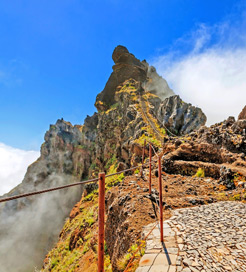
-
Recent Searches
Recent Searches
- Travel Alerts
- My Account
- Customer Service
-
United Kingdom

Compare ferries from Flores to Pico
There is currently just the 1 ferry route running between Flores and Pico operated by 1 ferry company – Atlanticoline. The Lajes to Sao Roque ferry crossing operates weekly with a scheduled sailing duration from about 7 hours 15 minutes.
Whilst we’ve taken great care to ensure the information on this page is correct, as the frequency and duration of crossings on all routes can vary from time to time we’d advise that you get a live quote for current availability on this Flores Pico crossing between Lajes and Sao Roque.
Flores Pico Ferry Map
About Flores:
Flores is the westernmost island of the Azores, an autonomous region of Portugal in the North Atlantic Ocean.
Regarded as the most attractive island of the archipelago, Flores has a ruggedly beautiful terrain consisting of magnificent crater lakes, dramatic cliffs plummeting into the ocean and vibrantly coloured flowers blanketing the coastal plains.
The village of Faja Grande is the most westerly in Europe, set before a large natural bowl with picturesque waterfalls and plunge pools, whereas the capital, Santa Cruz is ideal for birdwatching.
Flores is a fantastic canyoning and hiking destination, too, thanks to the large number of cascades throughout the unspoilt, hilly landscape. However, there are also plenty of lovely beaches if you would prefer a more relaxed day on the island.
Flores is the only Azorean island to provide ferry crossings to Corvo, which means it offers the most routes of the island group. From the capital in the north and the village of Lajes Das Flores to the south, you can sail to anywhere in this beautiful Portuguese archipelago.
About Pico:
Pico is a large island in the Central Group of the Azores, a Portuguese archipelago in the heart of the North Atlantic Ocean.
With its formidable, albeit dormant, namesake volcano commanding the horizon, Pico’s grand landscape offers some of the best hiking and climbing in the Azores. The ever changing scenery makes for some gorgeous backdrops, with brightly coloured exotic plants giving way to vast lava rock formations and enticing, natural swimming holes, offering unforgettable walks and bike rides. Pico also has a rich history and deep-rooted links to the whaling industry, ever since it was discovered in the mid-fifteenth century, while boasting a long-standing fine wine culture, with its unique vineyard landscape commended by UNESCO in 2004.
As part of the Central Group, Pico is well linked to the majority of islands in the archipelago by ferry, with vessels docking in the town of Sao Roque on the north coast.


